Diwata-1 / PHL-Microsat-1(Philippine Scientific Earth Observation Microsatellite-1)
EO
Mission complete
Imaging multi-spectral radiometers (vis/IR)
High resolution optical imagers
Diwata-1 is a microsatellite, part of the PHL-Microsat program, a Philippine government program with the aim of launching two microsatellites by 2050. Diwata-1 was launched to the ISS (International Space Station) on 23 March, 2016, from where it was deployed into orbit on 27 April, 2016. It completed its mission on 5 April, 2020, burning up in Earth’s atmosphere.
Quick facts
Overview
| Mission type | EO |
| Agency | DOST-ASTI |
| Mission status | Mission complete |
| Launch date | 27 Apr 2016 |
| End of life date | 05 Apr 2020 |
| Instruments | WFC, HPT, SMI |
| Instrument type | Imaging multi-spectral radiometers (vis/IR), High resolution optical imagers |
| CEOS EO Handbook | See Diwata-1 / PHL-Microsat-1(Philippine Scientific Earth Observation Microsatellite-1) summary |
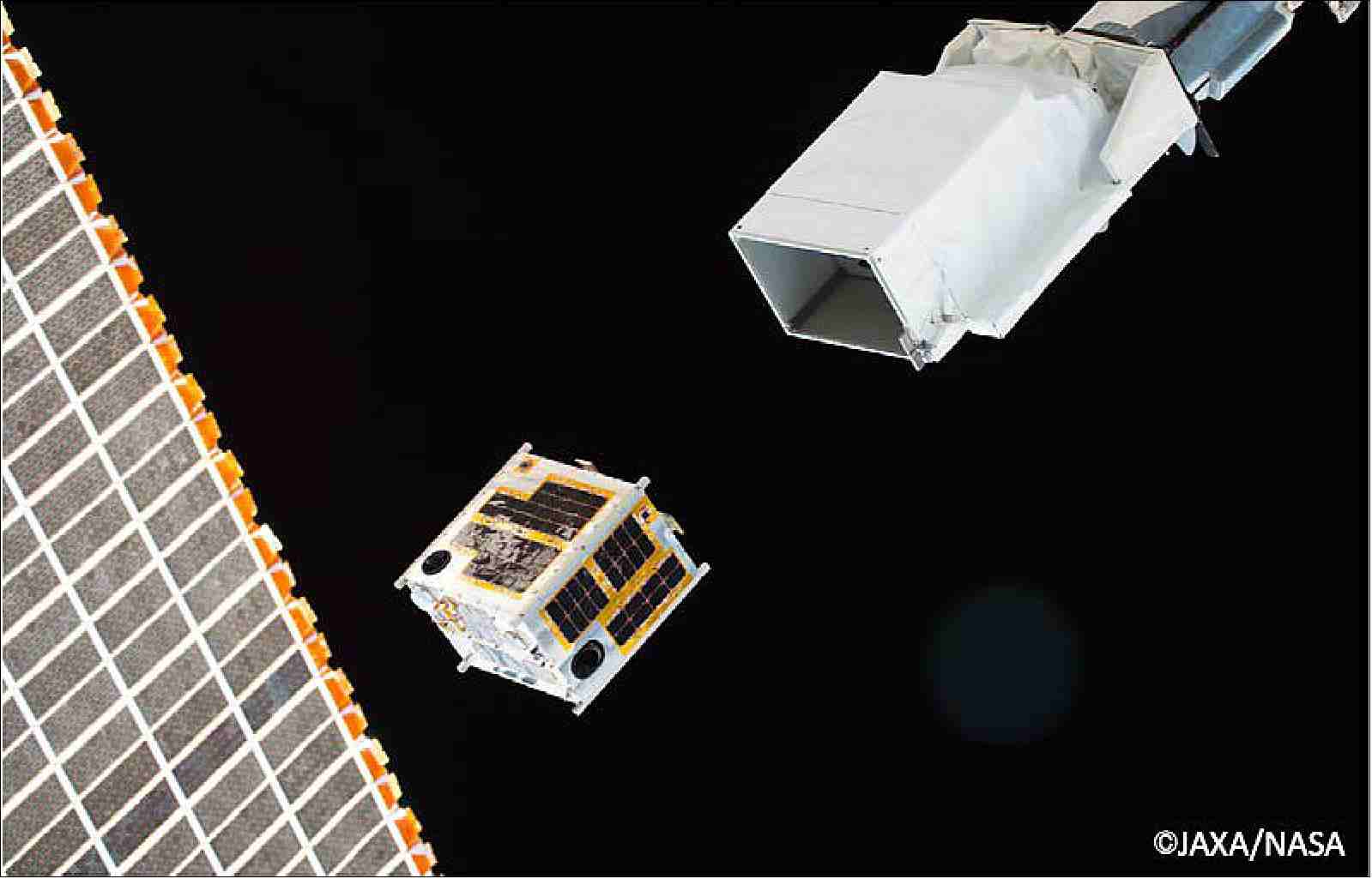
Summary
Mission Capabilities
The sensor complement of Diwata-1 consists of three instruments, HPT (High Precision Telescope), SMI (Space-borne Multispectral Imager) and WFC (Wide Field Camera). HPT is a high spatial resolution imager with the primary applications of determining the extent of damages caused by natural disasters and the monitoring of historical and cultural sites. SMI is a multispectral imager equipped with an LCTF (Liquid Crystal Tunable Filter) that monitors ocean productivity, changes in vegetation and phytoplankton biomass. WFC observes cloud patterns and distributions, and monitors weather disturbances, such as tropical storms, with a wide field of view and a panchromatic CCD (charge coupled device), that only permits black and white imaging.
Performance Specifications
HPT has a GSD (ground sampling distance) of 3 m, with a CCD for each spectral band (red, blue, green, near-infrared) and a FOV (Field of View) of 1.9 x 1.4 km. SMI has a spatial resolution of 80 m, and two CCDs with spectral intervals of 13 nm covering the visible (420-700 nm) and near-infrared (650-1050 nm) regions. WFC has the lowest spatial resolution, at 7 km, and has an FOV of 180° x 134°. Diwata-1 was deployed into a low-earth orbit at an altitude of approximately 400 km and an inclination of 51.6°.
Space and Hardware Components
The microsatellite bus was designed by the Philippine Department of Science and Technology (DOST) and Advanced Science and Technology Institute (ASTI), based on existing designs for RISESAT and RISING-2 modules. The spacecraft had a mass of 50 kg, and dimensions 0.55 m x 0.35 m x 0.55 m. Diwata-1 also carried an engineering payload, MFC (Mid-Field Camera), an imaging tool with a coloured CCD and a spatial resolution of 185 m, which was used to calibrate the altitude determination algorithm and assist location of images captured by the HPT and SMI sensors.
Diwata-1 / PHL-Microsat-1 (Philippine Scientific Earth Observation Microsatellite-1)
Spacecraft Launch Mission Status Sensor Complement Ground Segment References
The Philippines will launch its very own microsatellites into space in 2016 and 2017, according to the announcement of DOST (Department of Science and Technology) of the University of the Philippines. PHL-Microsat is a Philippine Government Program with the goal to send two microsatellites into space to assist in disaster management programs, weather forecasting, agriculture, fisheries, forest protection, mining, and even the protection of cultural and historical sites.
Background: Hokkaido University and Tohoku University of Japan initiated a project to send 50 microsatellites into space by 2050. The project will photograph aftermaths of natural disasters, partnering with governments, universities and other organizations based in Bangladesh, Indonesia, Malaysia, Myanmar, Mongolia, Philippines, Thailand, and Vietnam. Two satellites are commissioned for the Philippine government. 1) 2)
Diwata-1 is the first satellite of the venture and is also a part of the DOST (Department of Science and Technology) Philippine Scientific Earth Observation Microsatellite (PHL-Microsat) Program, which was initiated in December 2014 by the government agency. Diwata is the nickname of the program, named after a Filipino mythological character Diwata (fairy).
The observation data of Diwata are expected to enable DOST's PAGASA (Philippine Atmospheric, Geophysical and Astronomical Services Administration) to make accurate forecasts and weather monitoring that is crucial in agriculture. The data will also be used to predict extreme weather systems like the El Niño phenomenon that can dramatically affect agricultural productivity and crop yield and threaten food security.
One of the major goals of the PHL-Microsat program, to which Diwata-1 belongs, is to boost the progress on the creation of the Philippine Space Agency. DOST secretary Mario Montejo said that the Diwata-1 endeavor may pave the way for development of the local electronics and aerospace industries which would complement a satellite-building industry.
The UP (University of the Philippines), Diliman campus, has allocated an area for a space research laboratory for the continued development of microsatellite technology, where the Filipino scientists were involved in the Diwata-1 project can teach and train local engineers. The facility will be funded by the Philippine Council for Industry, Energy and Emerging Technology Research and Development of the DOST.
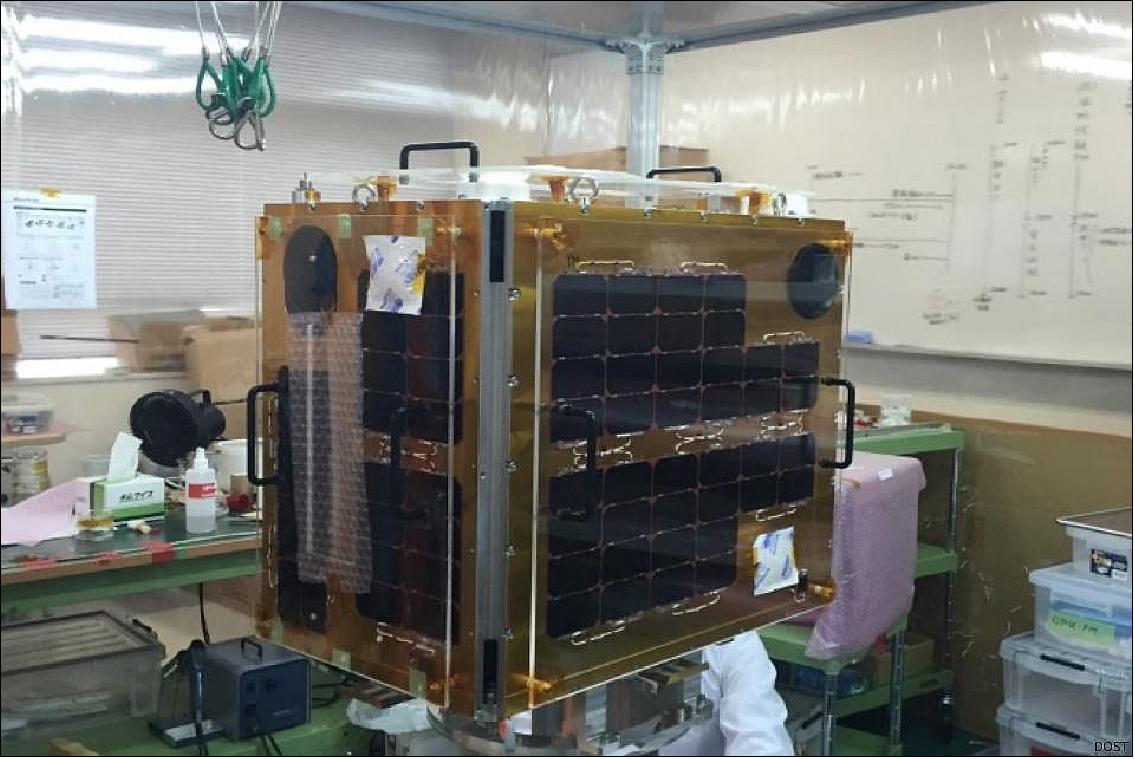
Spacecraft
A team of nine Filipino engineers from the DOST/ASTI (Advanced Science and Technology Institute) and the University of the Philippines, dubbed the "Magnificent 9", were responsible for the development and production of Diwata-1 and collaborated with scientists and engineers from the two Japanese universities, Hokkaido University and Tohoku University.
The Tohoku team was in charge of the Diwata-1 bus development working on the different aspects of the bus system (electrical, mechanical, etc). They patterned/reuse design from existing RISESAT and RISING-2 modules. In addition, they performed all the necessary test to ensure the operational stability of the microsatellite (electrical, vibration, off-gas, thermal, fit-check tests to name a few). 3)
The Hokkaido team was charge with the DIWATA-1 payload. This included the selection and calibration of the optical sensors to conform to the science missions. It involved also the processing of the raw data from the sensors towards valuable high level end products.
The Diwata microsatellite has a mass of 50 kg, a size of 55 cm x 35 cm x 55 cm, and face-mounted solar panels provide power for operations of the spacecraft.
Diwata-1 was handed over to JAXA (Japan Aerospace Exploration Agency) on January 13, 2016 at the Tsukuba Space Center in Tsukuba, Japan. On January 18, 2016, JAXA sent the microsatellite to NASA (National Aeronautics and Space Administration), in the United States, after conducting final tests on the satellite.
The release of a microsatellite, using J-SSOD (JEM Small Satellite Orbital Deployer) from the ISS/JEM ( Japanese Experiment Module)/ Kibo will mark the first time deployment ever of a microsatellite. The Philippine government sponsored the development and launch of the satellite, while its deployment from Kibo will be conducted under a paid-utilization contract between JAXA and Tohoku University. 4)
According to DOST, Diwata-1 is the first microsatellite owned by the Philippine government involving Filipino engineers in its development. The satellite is intended to observe Earth, monitor climate changes, and develop human resources. Tohoku University and Hokkaido University each welcomed the reception of Filipino students and researchers. As such, Diwata-1 was co-built in Japan by Japanese and Filipino engineers, whereas Tohoku University technically supported its satellite bus, and Hokkaido University supported the development of such payload as a mission sensor.
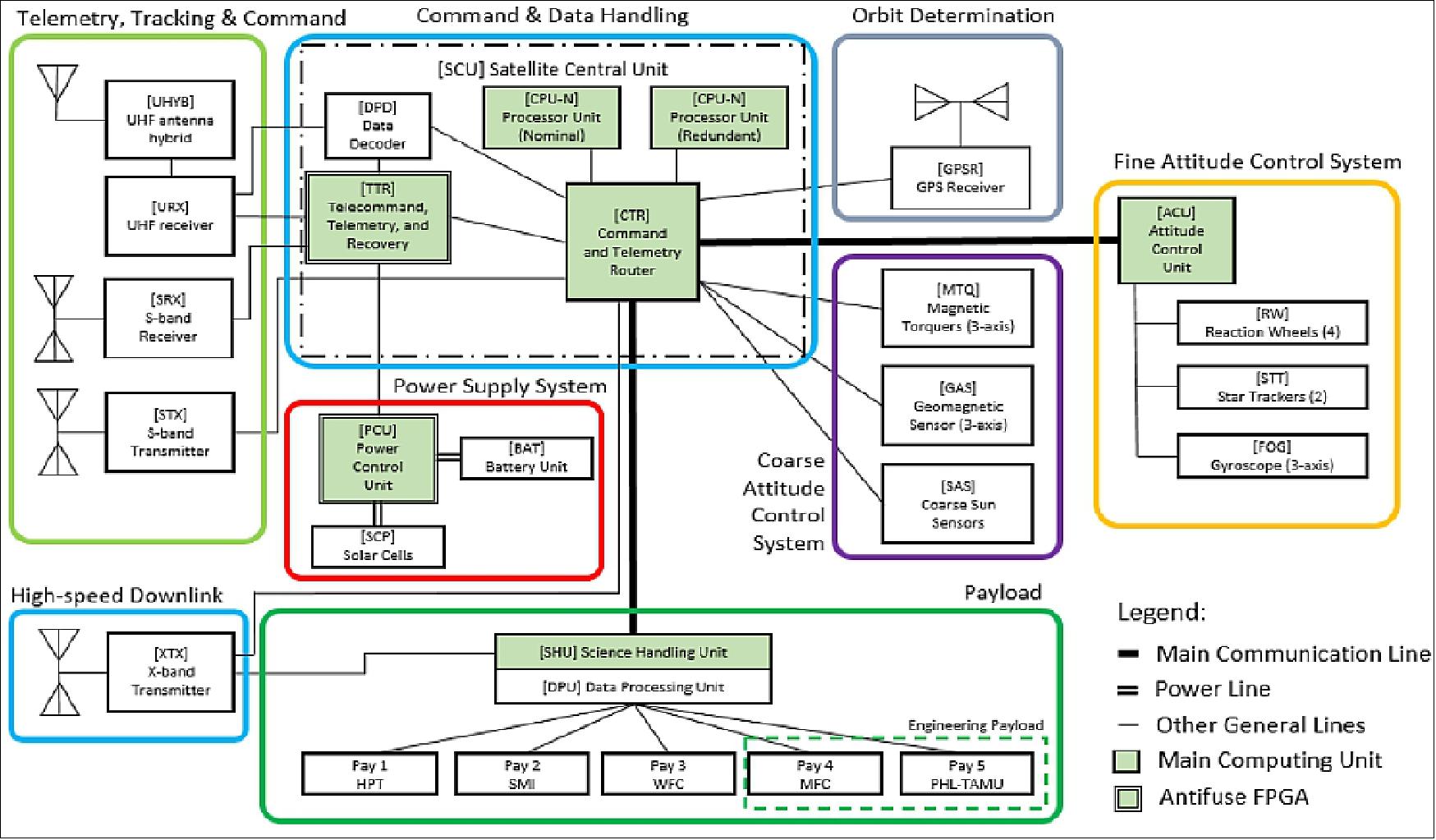
The Bus Development Team worked on the design, implementation and testing of various structural, mechanical and electrical aspects of the microsatellite bus. The electrical subsystems, in particular, include the power supply, computing and communication blocks, software programming, attitude control and the science payload interface or handling unit. ÅAC Microtec of Uppsala, Sweden, supplied a key avionics component for Diwata-1. 5)
The Payload and Mission Design Team on the other hand, contributed to the science mission analysis and objectives that lead to the specifications of the payload sensors and instruments. The team studied the technical specifications of the payload instruments towards proper testing and calibration of its outputs. It is also engaged in the processing of the raw data from the sensors towards valuable high-level end products or images. Both teams are also involved in understanding the design and operational details of the ground station for controlling the microsatellite and for receiving its data.
These efforts resulted to the development and integration of the bus system with its payload instruments into a microsatellite, now known as "Diwata". The microsatellite was subjected to different parametric and functionality tests, including shock and vibration, off-gas, fit-check and post-vibration electrical tests. The final assembly and the final vibration test on Diwata were done last December 2015.
The PHL-Microsat Team also intends to develop course and training materials on small satellite technology design and testing, which are proposed to be incorporated into science and engineering undergraduate and postgraduate elective courses as well as for local industry short seminars. A microsatellite simulator and testbed, antenna design and testing facility and amateur radio satellite station are also currently being set up as part of the establishment of the local Microsatellite Research and Instructional facility within UP Diliman.
ADCS (Attitude Determination and Control Subsystem):
STT (Star Tracker Telescopes) | Range: 4th magnitude stars, FOV: 27.8 degrees |
SAS (Sun Aspect Sensor) | 6 solar cells (one on each panel) |
RWs (Reaction Wheels) | Power: 3.25W each (no rotation), 3.91W each (2000RPM) |
Magneto-torquers | Moment: 1.6 ATm2, Power: 5 V, 200 mA |
GAS (Geomagnetic Aspect Sensor) | Range: -0.6 to +0.6 gauss, Output voltage: +1.9 V to +3.1 V |
GPS Receiver |
|
ACU (Attitude Control Unit) | Power: 1.97 W, Handles all attitude related calculations |
FOG (Fiber Optic Gyroscope) | Range: ±5º/s |
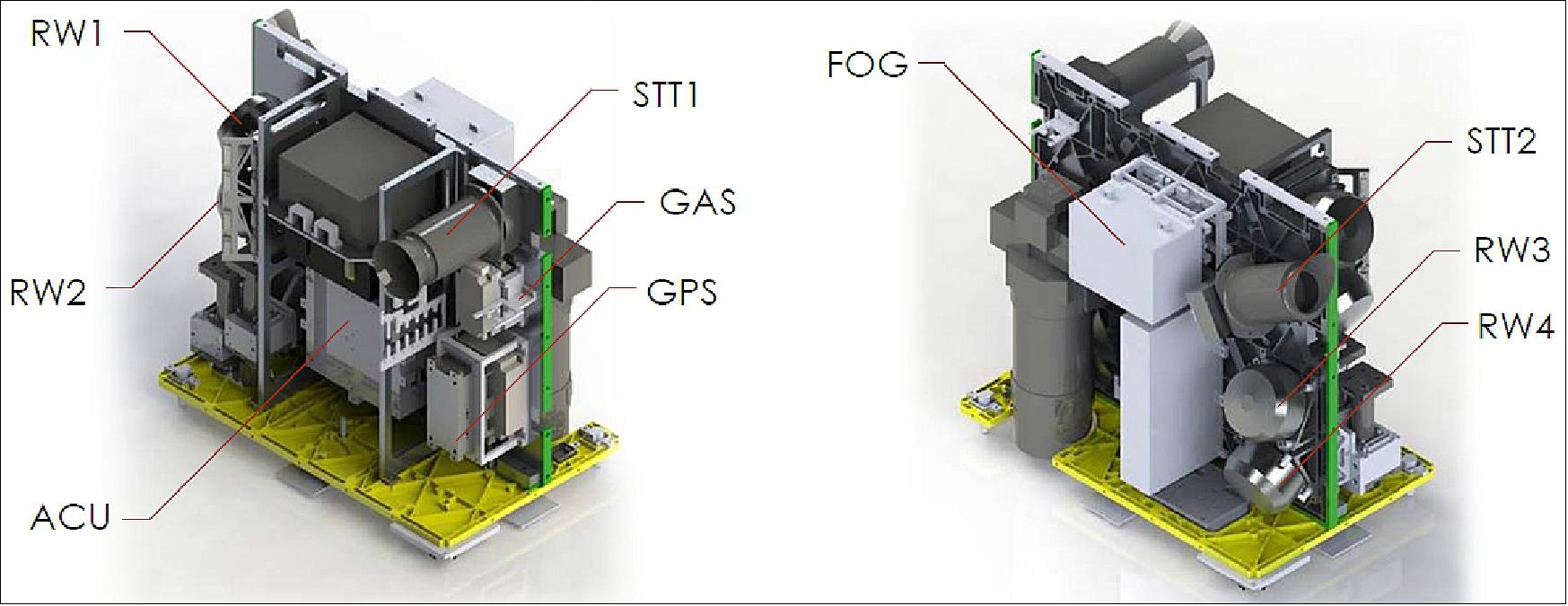
EPS (Electrical Power Subsystem):
• Battery:
- Ni-MH (Nickel Metal Hydride)
- Capacity: 7400 mAh
- Configuration: 9 series x 2 parallel
• Solar cells:
- 19 strings of photovoltaic (PV) cells
- Average power generation: 39 W
- Charging capacity: 41,900 mAh / day
• PCU (Power Control Unit)
- Handles all the power requirements of the modules
- Mass: 1.85 kg
RF communications:
Band | Output power | Data rate | Bandwidth | Link margin |
X-band downlink | 0.5 W | 2.4 Mbit/s | 10 MHz | 10.3 dB |
S-band downlink | 0.1 W | 100 kbit/s | 400 kHz | 4.1 dB |
S-band uplink | 50 W | 1 kbit/s | 65.2 kHz | 51.0 dB |
UHF uplink | 50 W | 1.2 kbit/s | 15 kHz | 23.8 dB |
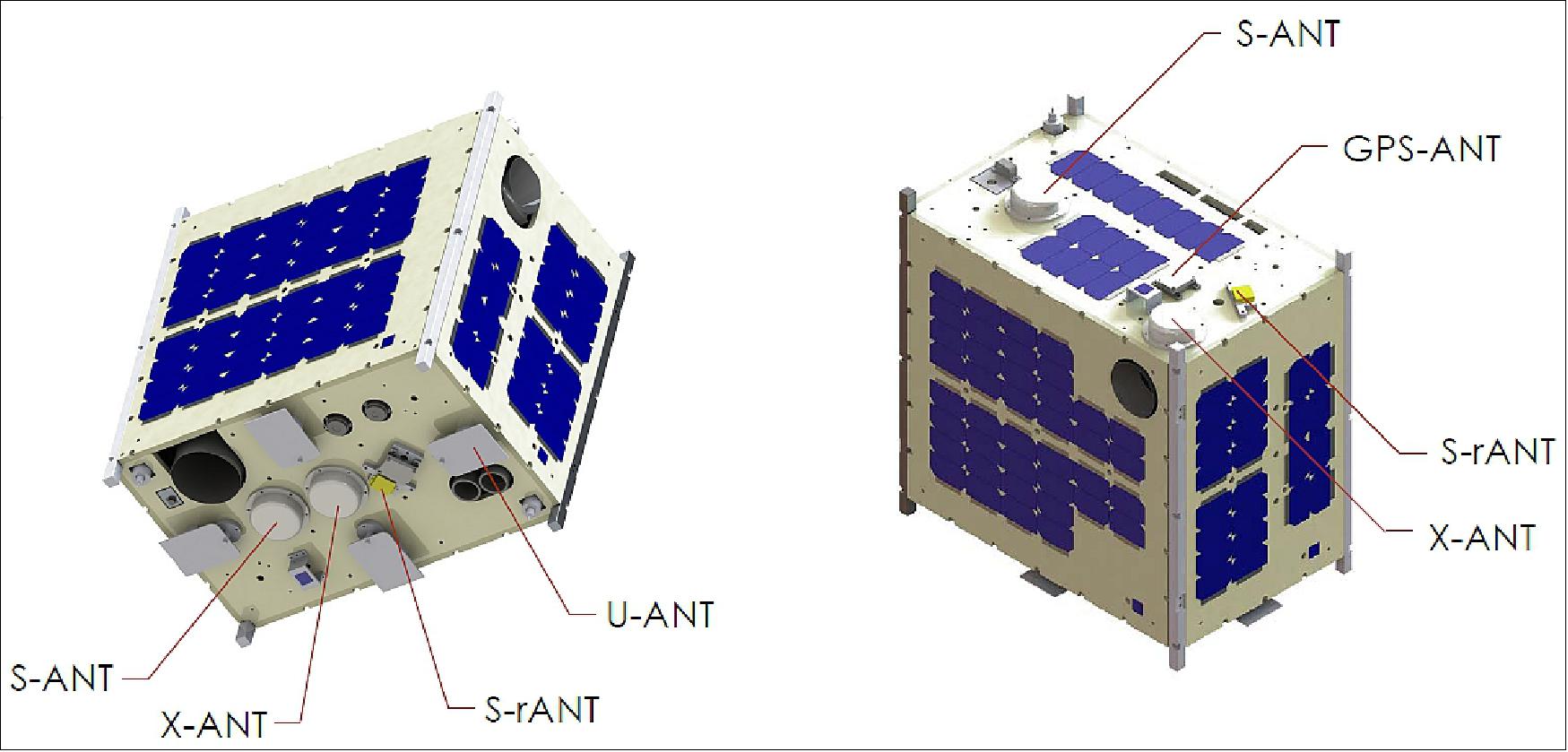
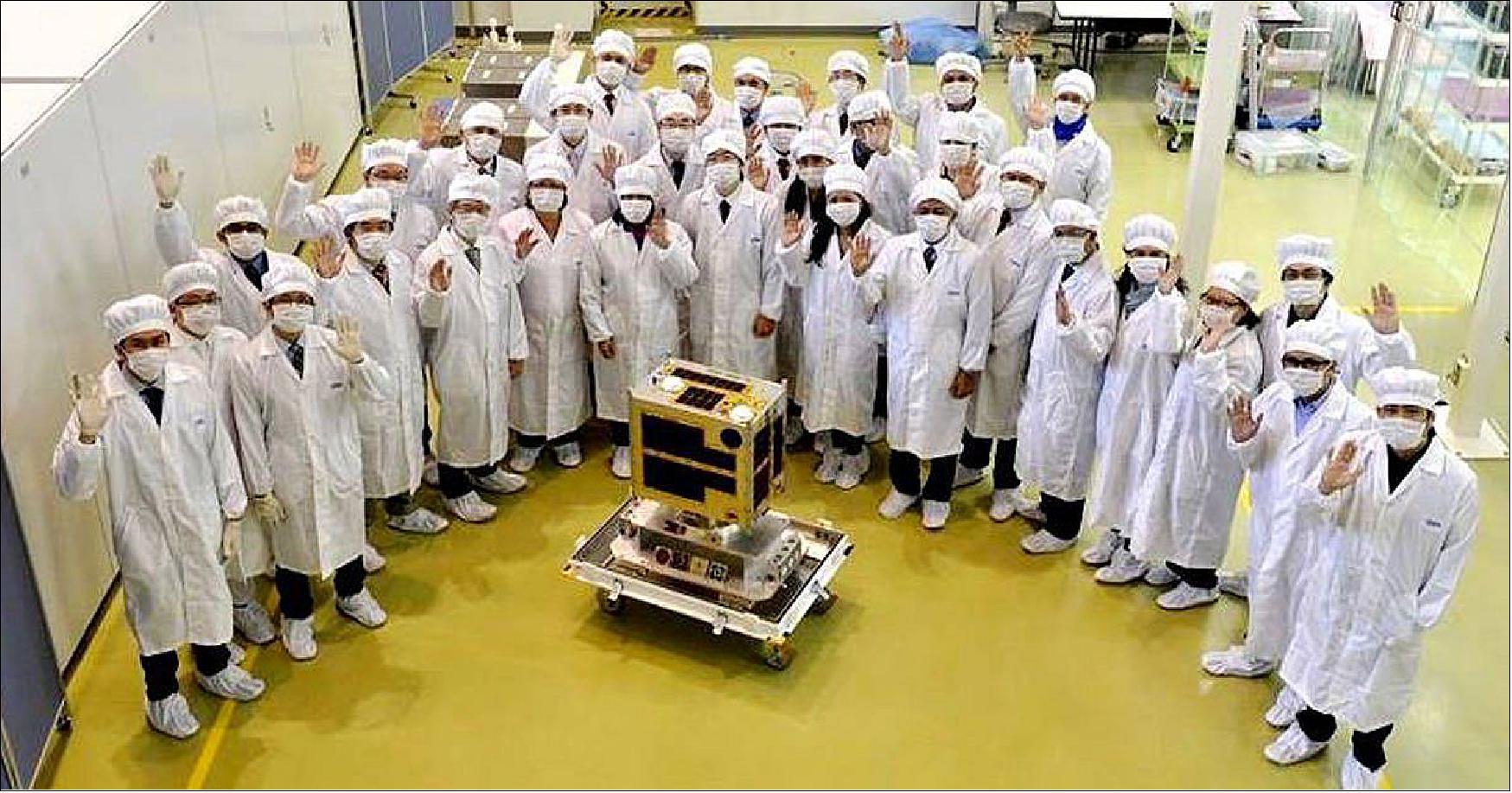
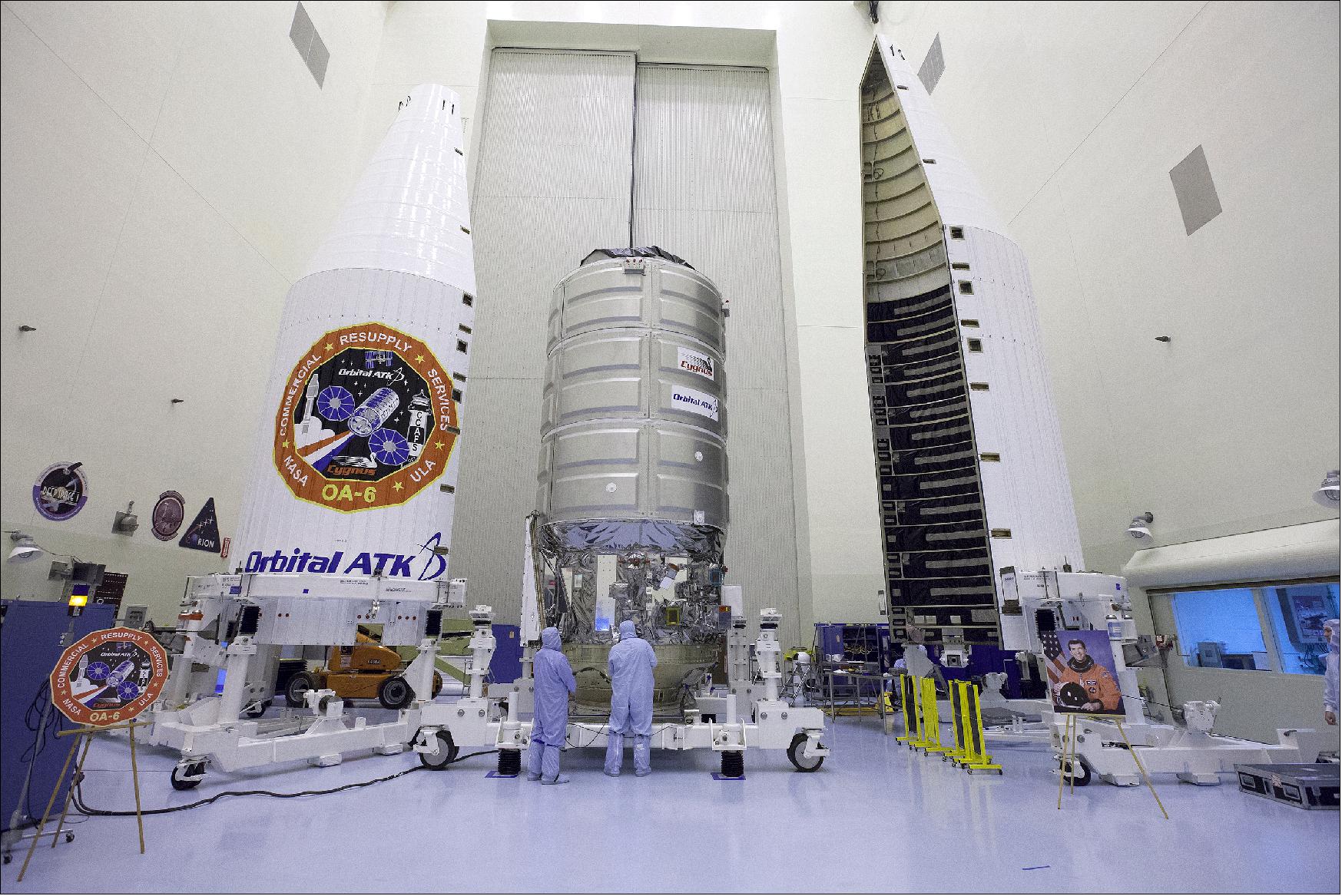
Launch: The Diwata-1 microsatellite was launched on March 23, 2016 (03:05:51 UTC) as a secondary payload of the Cygnus CRS OA-6 cargo of the commercial OA (Orbital ATK) mission and the second flight of an enhanced Cygnus spacecraft to the ISS. NASA partner Orbital ATK launched its unmanned Cygnus cargo ship from Cape Canaveral, Florida, atop a United Launch Alliance Atlas-5 rocket. This was the second flight of an enhanced Cygnus spacecraft to the ISS and the fifth of ten flights by Orbital ATK under the Commercial Resupply Services contract with NASA. 7) 8)
Cygnus spacecraft are named after former astronauts. OA-6 is named the SS Rick Husband, after the commander of Space Shuttle Columbia's ill-fated STS-107 mission. Husband was killed on February 1, 2003 when the Columbia space shuttle disintegrated as she reentered Earth's atmosphere at the end of a two-week microgravity research mission. None of the seven astronauts aboard survived.
Orbit: The near-circular orbit of the ISS is at a nominal altitude of ~400 km with an inclination of 51.6º.
The deployment of Diwata-1 from the ISS using the J-SSOD from JEM/Kibo is planned for May 2016.
Cygnus carried a total cargo of 3513 kg of science and research, crew supplies and vehicle hardware to the orbital laboratory to support dozens of science and research investigations that will occur during Expeditions 47 and 48. 9)
The Cygnus spacecraft will arrive at the station on March 26, at which time Expedition 47 Commander Tim Kopra of NASA and Flight Engineer Tim Peake of ESA (European Space Agency) will grapple Cygnus, using the space station's robotic arm. After Cygnus capture, ground commands will be sent from mission control in Houston to the station's arm to rotate and install the spacecraft on the bottom of the station's Unity module. Cygnus will remain at the space station until May, when the spacecraft will be used to dispose of several tons of trash during its fiery reentry into Earth's atmosphere.
A few of the scientific highlights: 10) 11)
• Gecko Gripper, testing a mechanism similar to the tiny hairs on geckos' feet that lets them stick to surfaces using an adhesive that doesn't wear off.
• Meteor, an instrument to evaluate from space the chemical composition of meteors entering Earth's atmosphere. The instrument is being re-flown following its loss on earlier supply missions.
• Saffire, which will set a large fire inside the Cygnus in an unprecedented study to see how large fires behave in space. The research is vital to selecting systems and designing procedures future crews of long-duration missions can use for fighting fires.
• Strata-1 to study regolith behavior in microgravity (to investigate how easy or difficult it is to anchor a spacecraft in regolith). The Strata-1 experimental facility exposes a series of regolith simulants, including pulverized meteorite material, glass beads, and regolith simulants composed of terrestrial materials and stored in multiple transparent tubes, to prolonged microgravity on the space station. 12)
• AMF (Additive Manufacturing Facility) of Made In Space Inc. of Mountain View, CA will be installed as a permanent AM (Additive Manufacturing) 3D printing device in an Express Rack. The AMF uses this technology to enable the production of components on the space station for both NASA and commercial objectives.
• Cygnus is carrying more than two dozen nanosatellites that will be ejected from either the spacecraft or the station at various times during the mission to evaluate a range of technology and science including Earth observations.
• Diwata-1 is a microsatellite (50 kg) of the University of the Philippines.
Mission Status
• May 12, 2020: Diwata-1, the Philippines' first microsatellite, has ended its four years in Earth orbit, burning up in the atmosphere on April 6, 2020. The microsatellite captured more than 17,000 images of the Philippines, covering 38% of the country's land area. Diwata-1 ushered in an age of Earth satellite observation in the Philippines, contributing to science-based approaches to planning, conservation, risk management, and mapping. 13)
- When reports came out that the microsatellite Diwata-1 of the Philippines had re-entered the Earth's atmosphere on April 6, ending its mission, it made headlines for being the first microsatellite designed, built and operated by Filipinos.
- Diwata-1 spent four years in space capturing images that have helped pave the way for the use of space technology to analyze environmental change in the Philippines, contributing to science-based approaches to conservation, risk management, and nationwide mapping.
- Through these observation technologies, researchers of the Space Technology and Applications Mastery, Innovation and Advancement (STAMINA4Space) Program estimated the impact of typhoons, floods, landslides, and forest fires based on the extent of damages. Government agencies in the disaster risk management sector were able to identify and confirm damaged areas.
- "The success of Diwata-1 is a demonstration of what a developing country like the Philippines can achieve if adequate resources and government support are given to science and technology," Gay Jane Perez, STAMINA4Space Program Leader, told Mongabay.
- Diwata-1 was launched on March 23, 2016, via the Atlas V rocket from Cape Canaveral, Florida, and released into orbit on April 27, 2016, from the International Space Station (ISS). After a four-year tour of the Earth, the last images of the Philippines it transmitted were of Samar province, taken on Dec. 28, 2019, while its final captures were made on Feb. 2, 2020.
- The microsatellite was projected to remain in orbit for only 18 months, but it stayed up more than twice as long. Ground controllers last made contact with it on April 6 when it passed over Sendai, Japan, at an altitude close to Earth's atmospheric boundary. Diwata-1 was presumed to have burned up in the atmosphere shortly after.
- In its wake, it paved the way for the country's aerospace program by providing hands-on training for researchers, scientists and engineers. It increased awareness about the use of space science and technology for environmental and biodiversity conservation measures for the benefit of not just lawmakers and policymakers but also the general public.
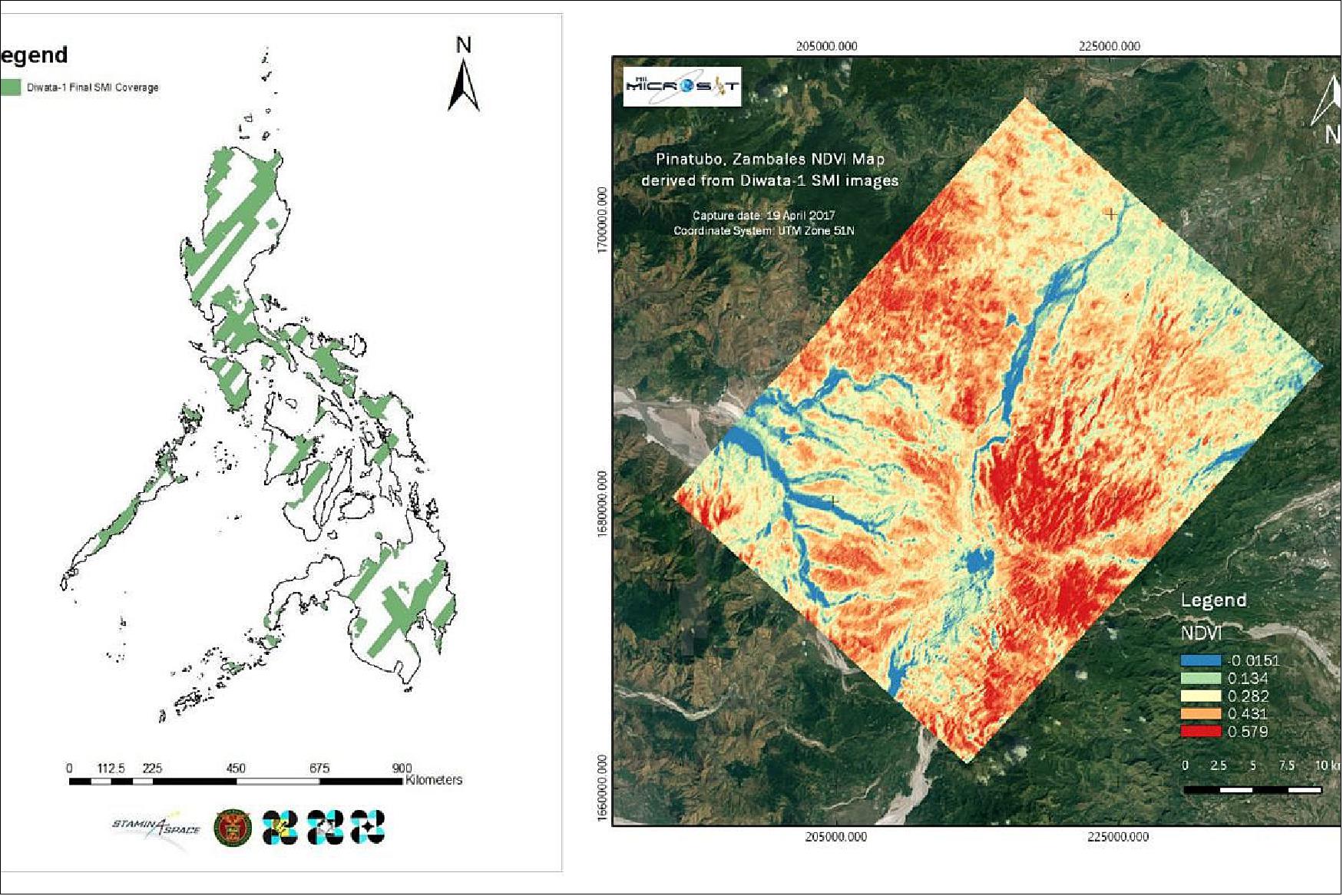
• December 31, 2017: Nearly 2 years now in its low-Earth orbit and having captured over 15,000 images, the work around the Diwata-1 continues under the PHL-Microsat program. How far has the Philippines' first microsatellite come since its release into orbit? And where is the Philippines headed in terms of advancing its capacity and knowledge in space technology? 14)
• On April 27, 2017, the DOST (Department of Science and Technology) and the men and women behind the PHL-Microsat program celebrated Diwata-1's first anniversary in orbit. 15) 16)
- During the celebration at the ASTI (Advanced Science and Technology Institute) office of the UP Diliman campus, DOST announced the planned launch and deployment of Diwata-2 into space by the second quarter of 2018 through JAXA's) H2A rocket managed by Mitsubishi Heavy Industries. The mission was rescheduled from its earlier target launch in late 2017.
- "With the success of Diwata-1 and the impending launch of Diwata-2 in 2018, the DOST is now planning for a third satellite," said Carlos Primo David, executive director of PCIEERD (Philippine Council for Industry, Energy and Emerging Technology Research and Development). - PCIEERD, an attached agency of DOST, is in charge of the Philippine Scientific Earth Observation Microsatellite (PHL-Microsat) program, which spearheaded the development and launch of Diwata-1.
- The highly successful launch of Diwata-1 and the impending launch of Diwata-2 in the second quarter of 2018 are paving the way for Diwata-3, David said, adding that a Japanese team is coming to Manila to discuss the plan.
• As of January 13, 2017, Diwata-1 has circled the world approximately 4,083 times, taking images not just of the Philippines but also of other parts of the Earth. Diwata-1 started its mission on April 27, 2016 when it was deployed successfully from the ISS (International Space Station). Since that day, we at the PHL-Microsat Program have been excited by what this represents for the future of our country in space exploration. 17)
• The Figures 8, 9, 10, 11, 12 and 13 are taken from Ref. 3), published in late December 2016. Diwata-1 is currently operational and continuously capturing images over the Philippines and elsewhere.

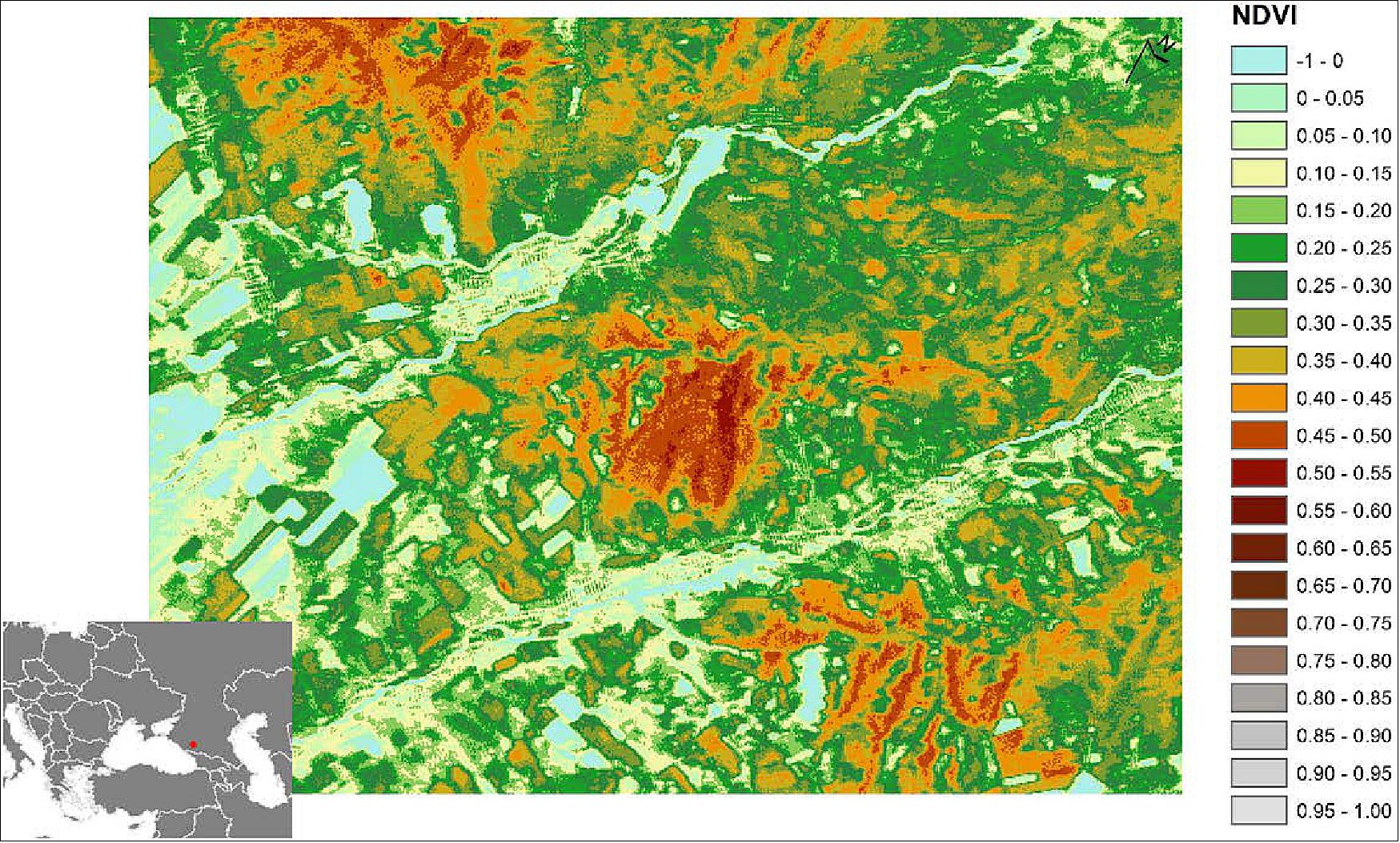
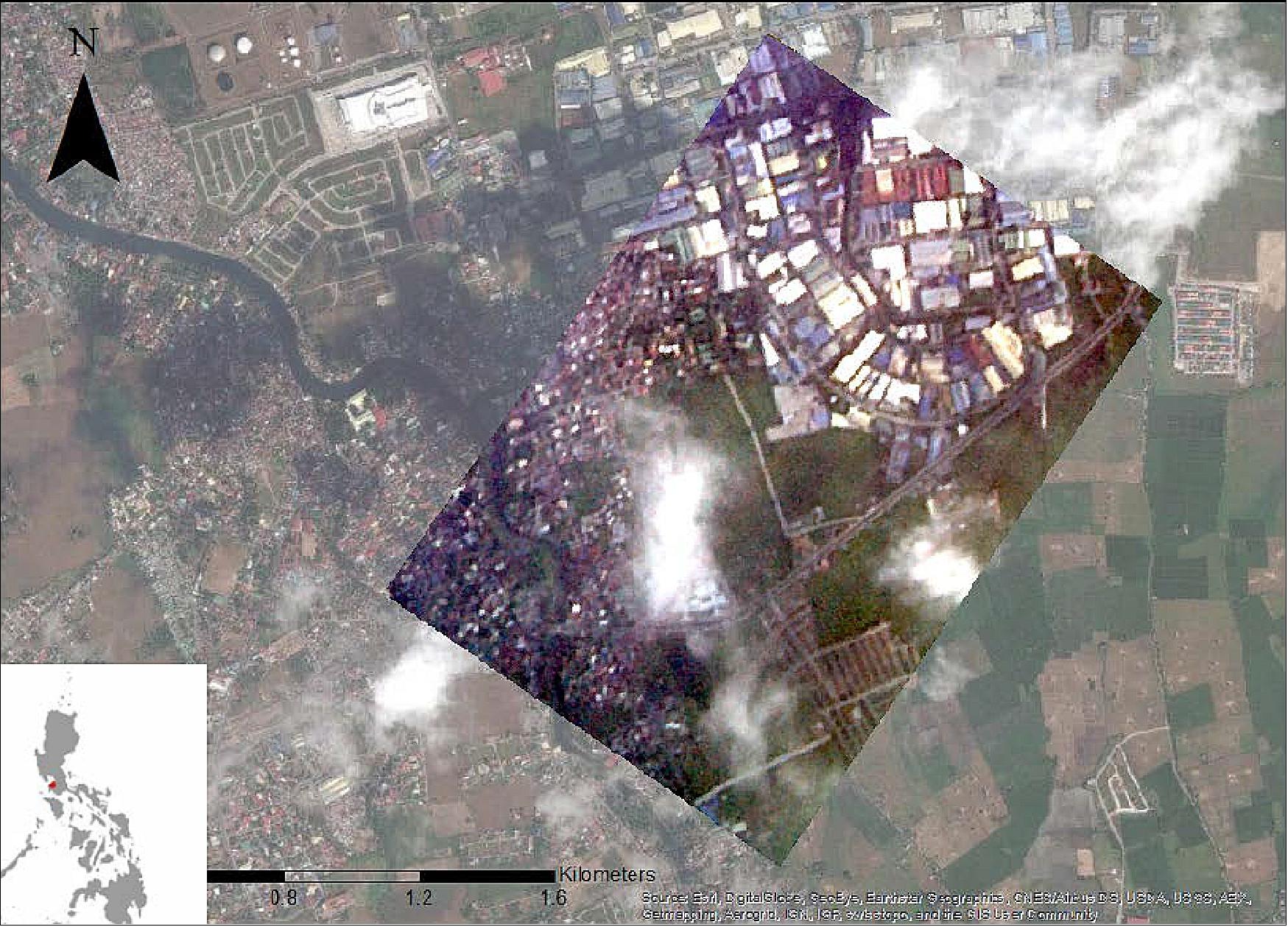
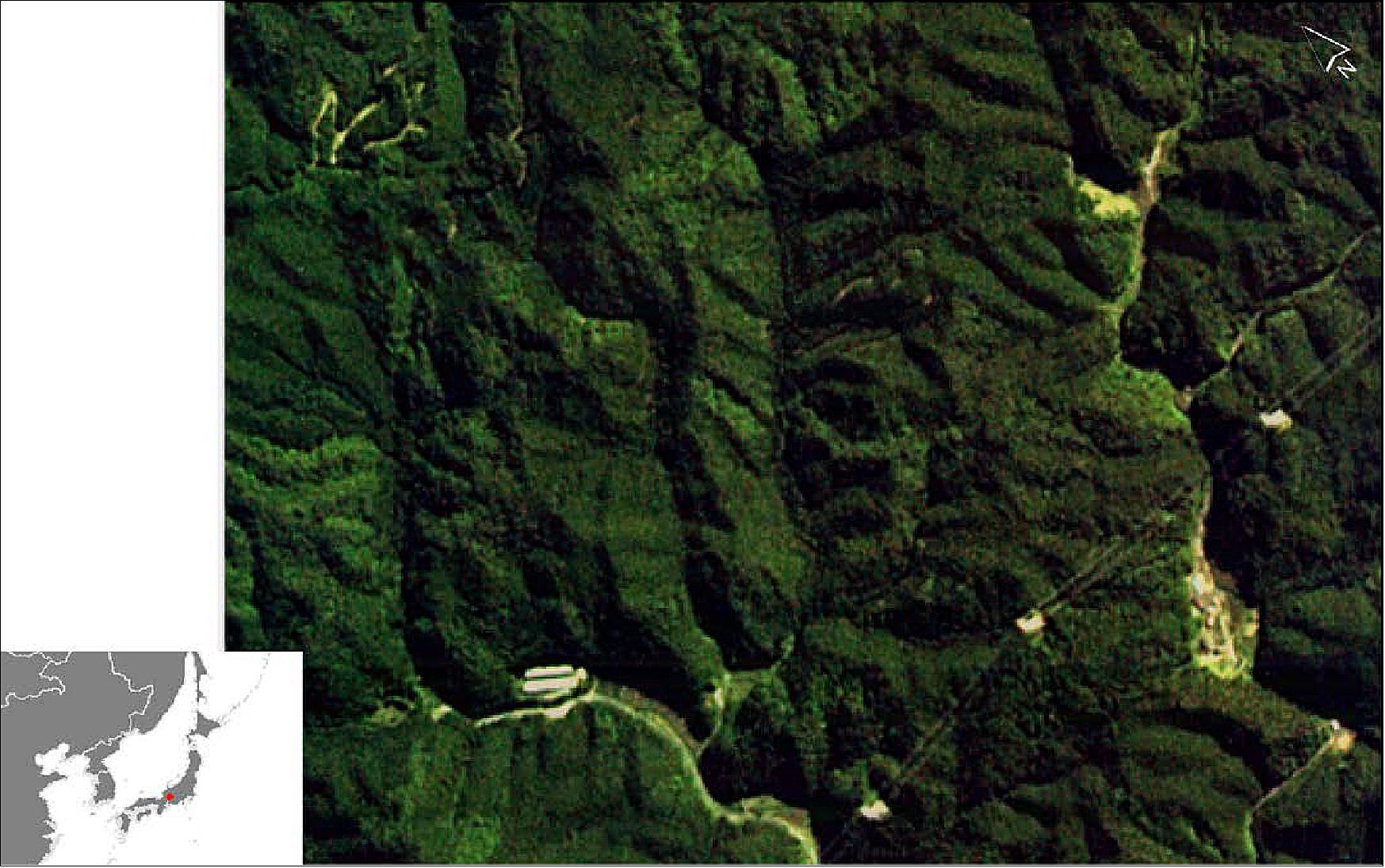
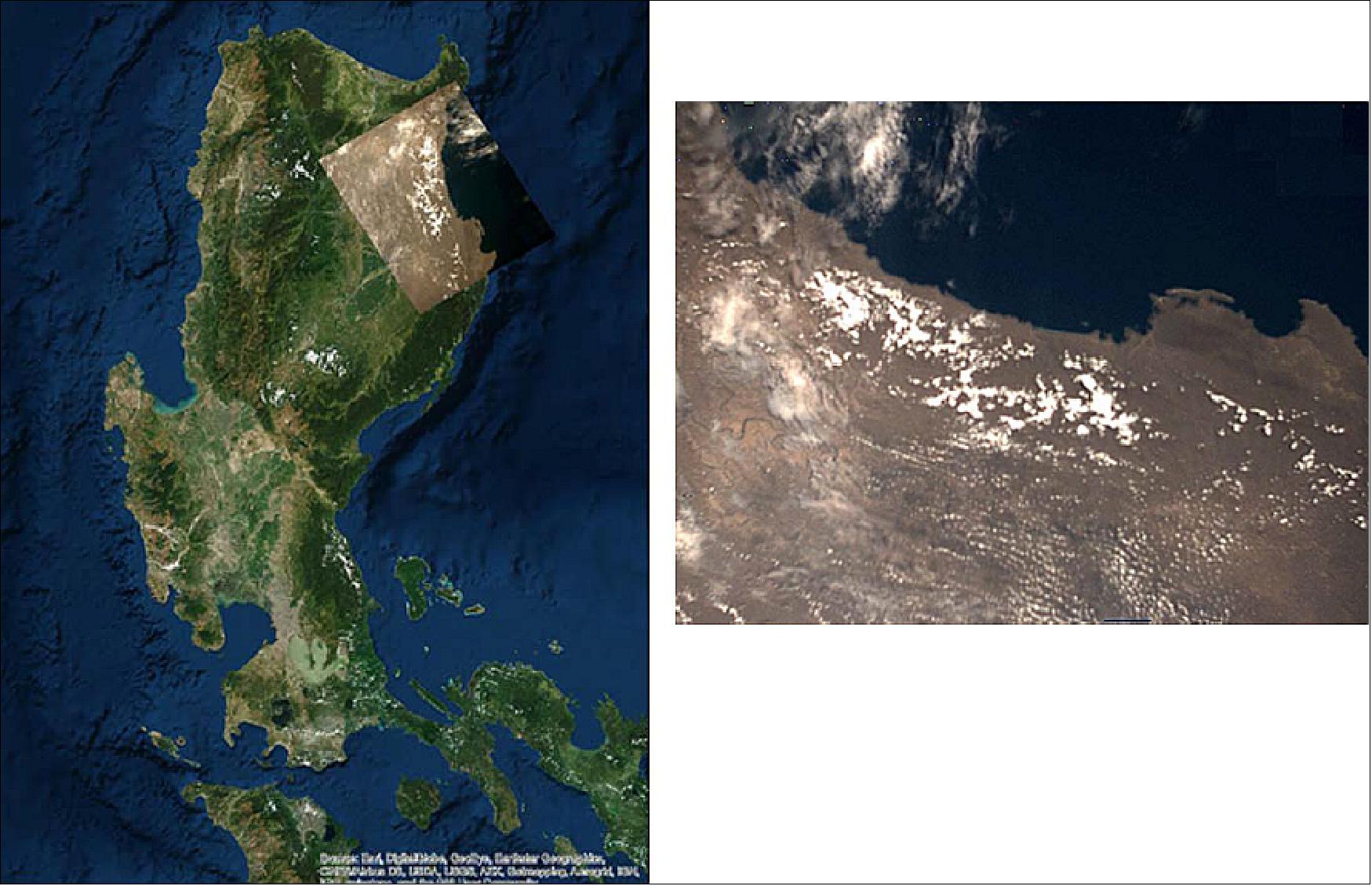
• The first image (Figure 13) of the WFC (Wide Field Camera) was obtained by the ground station of Tohoku University. This was verification that the attitude system of DIWATA-1 was working properly.
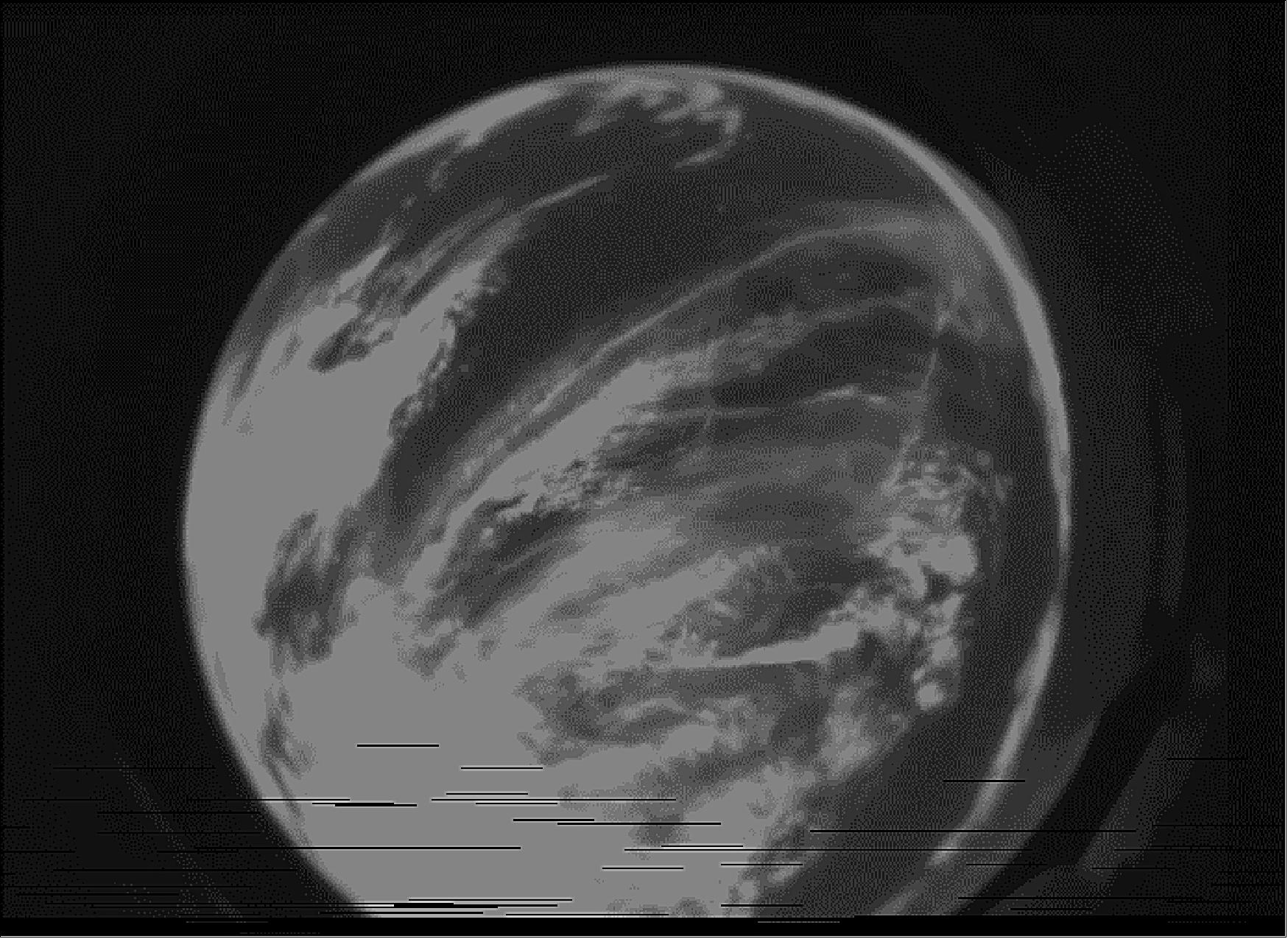
• The DIWATA-1 microsatellite was deployed from JEM/Kibo on April 27, 2016 at 11:45 UTC. JAXA was in charge of its launch and deployment into orbit. With this first success of deploying a 50 kg-class microsatellite, JAXA enhanced the deployment capacity from the ISS in addition to that of the CubeSat-class satellites. In the future, JAXA plans to increase the simultaneous deployment capacity of the CubeSat-class satellites from the current 6U to 12U, then to 18U; thus, JAXA expects more and more expansion of microsatellites use and operation in the Asian region and beyond, like this example of DIWATA-1, and through collaboration between overseas agencies and JAXA and Japanese universities. 18)
- The J-SSOD (JEM-Small Satellite Orbital Deployer) was installed to the JEM Airlock by the ISS crew/Jeffrey Williams as preparation of the deployment on April 21. For the DIWATA-1, the J-SSOD is using a specialized deployer for microsatellites installed on the MPEP (Multi-Purpose Experiment Platform). — After that the JSSOD was transferred to outside of the Kibo through the JEM Airlock and grappled by the JEMRMS (JEM Remote Manipulator System) to move the J-SSOD to its deployment position. The JEM RMS operations were conducted by ESA astronaut Tim Peake and the JFCT (JEM Flight Controller Team) in the MCR/SSIPC (Mission Control Room/ Space Station Integration & Promotion Center) of JAXA. As the "DIWATA" is a female fairy, also J-Flight Ms. Yurika Nakano and JCOM Ms. Sakurako Takahashi lead JFCT, and they issued the deployment command to the J-SSOD and then the DIWATA-1 was released successfully on April 27, 2016. 19)
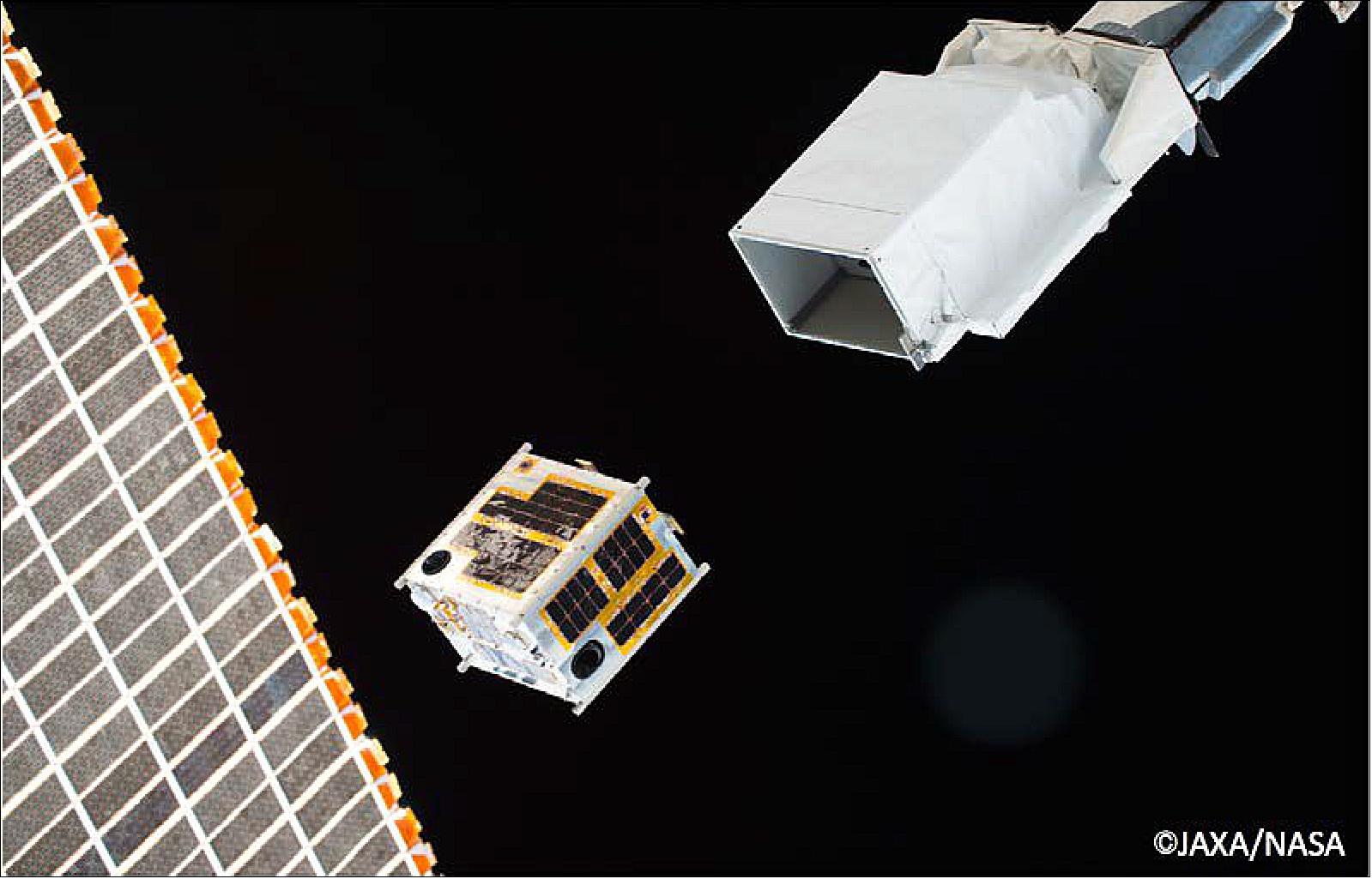
![Figure 15: Commemorative photo of the microsatellite development parties [DOST (Department of Science and Technology) of the University of the Philippines, Hokkaido University and Tohoku University] at the JAXA press conference after the DIWATA-1 deployment (image credit: JAXA)](/api/cms/documents/163813/6221795/Diwata_Auto5.jpeg)
• April 2016: DIWATA-1 is set to be deployed from the International Space Station from the Kibo module. The satellite will be inspected on board the station before it will be deployed into orbit in April for at least 18 months of program activity. The deployment mechanism for the satellite will be the J-SSOD (JEM Small Satellite Orbital Deployer).
Sensor Complement
HPT (High Precision Telescope)
DIWATA-1 is equipped with HPT that can determine the extent of damages from disasters, like typhoons and volcanic eruptions. It can also monitor changes in cultural and natural heritage sites, like the Mount Apo or the Mayon Volcano. The HPT, with a GSD (Ground Sample Distance) of 3 m, and a FOV of 1.9 km x 1.4 km from an orbital altitude of 400 km, is equipped with four CCDs, one for each spectral band (red, blue, green, and near infrared region). Images captured from the HPT will be used for disaster management and resource allocation. 20)
SMI (Spaceborne Multispectral Imager)
The SMI with LCTF (Liquid Crystal Tunable Filter) - with a spatial resolution of 80 m from an altitude of 400 km - will be used for monitoring vegetation changes and in estimating phytoplankton biomass in Philippine waters. The instrument is equipped with two CCDs for both visible (420–700 nm) and near infrared (650–1050 nm) regions with a 13 nm interval.
WFC (Wide Field Camera)
The WFC will be used in observing cloud patterns and their distribution as well as weather disturbances such as tropical storms. The WFC has a panchromatic CCD, a FOV (Field of View) of 180º x 134º, and a spatial resolution of 7 km. WFC operates only in panchromatic mode, using a CCD detector to deliver black-and-white photos.
MFC (Mid-Field Camera)
The MFC is an engineering payload with a colored CCD and an expected spatial resolution of 185 m in a FOV of 121 km x 91 km; it will help in the calibration of the attitude determination algorithm. It will assist in locating the images captured by the HPT and SMI.
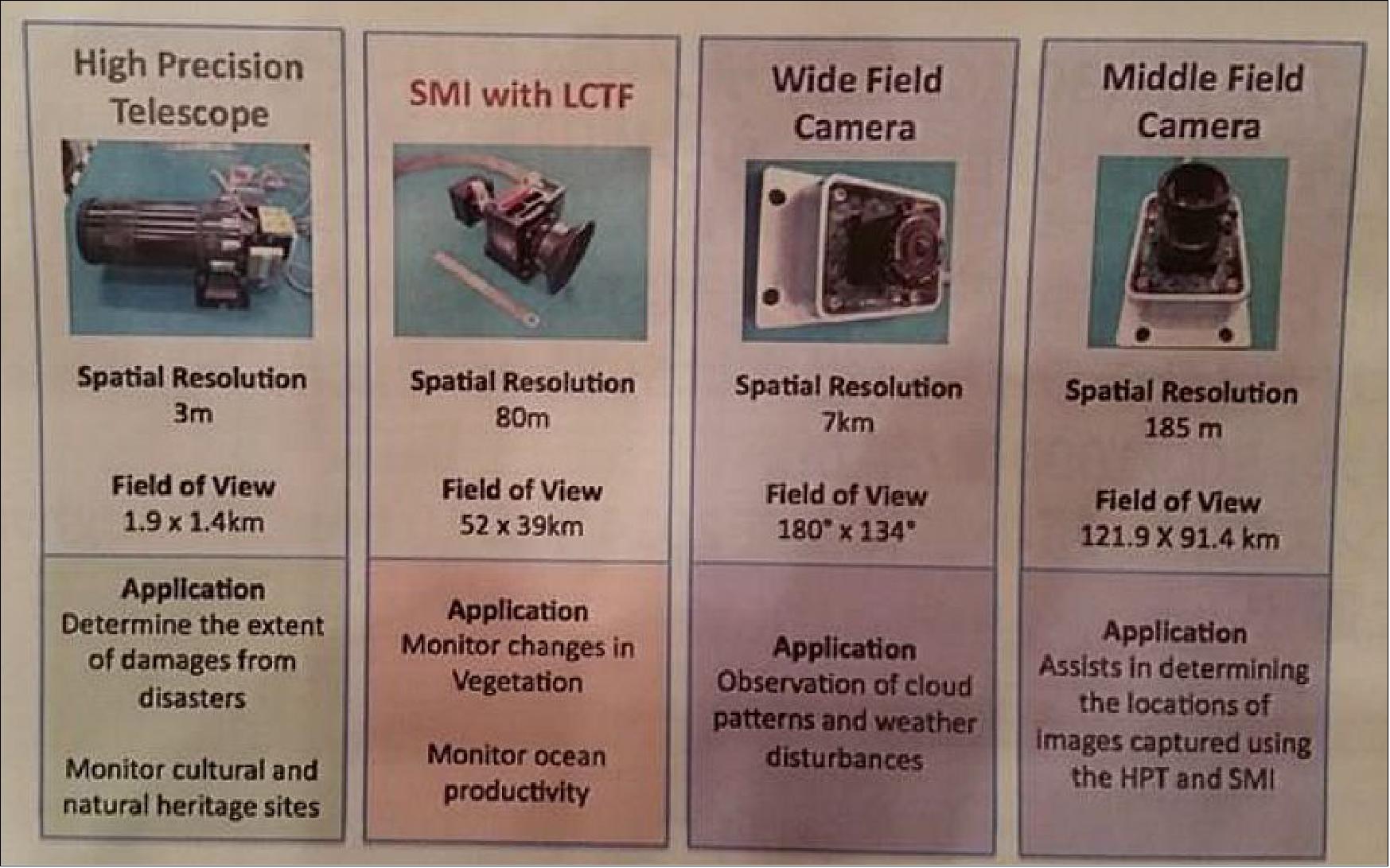
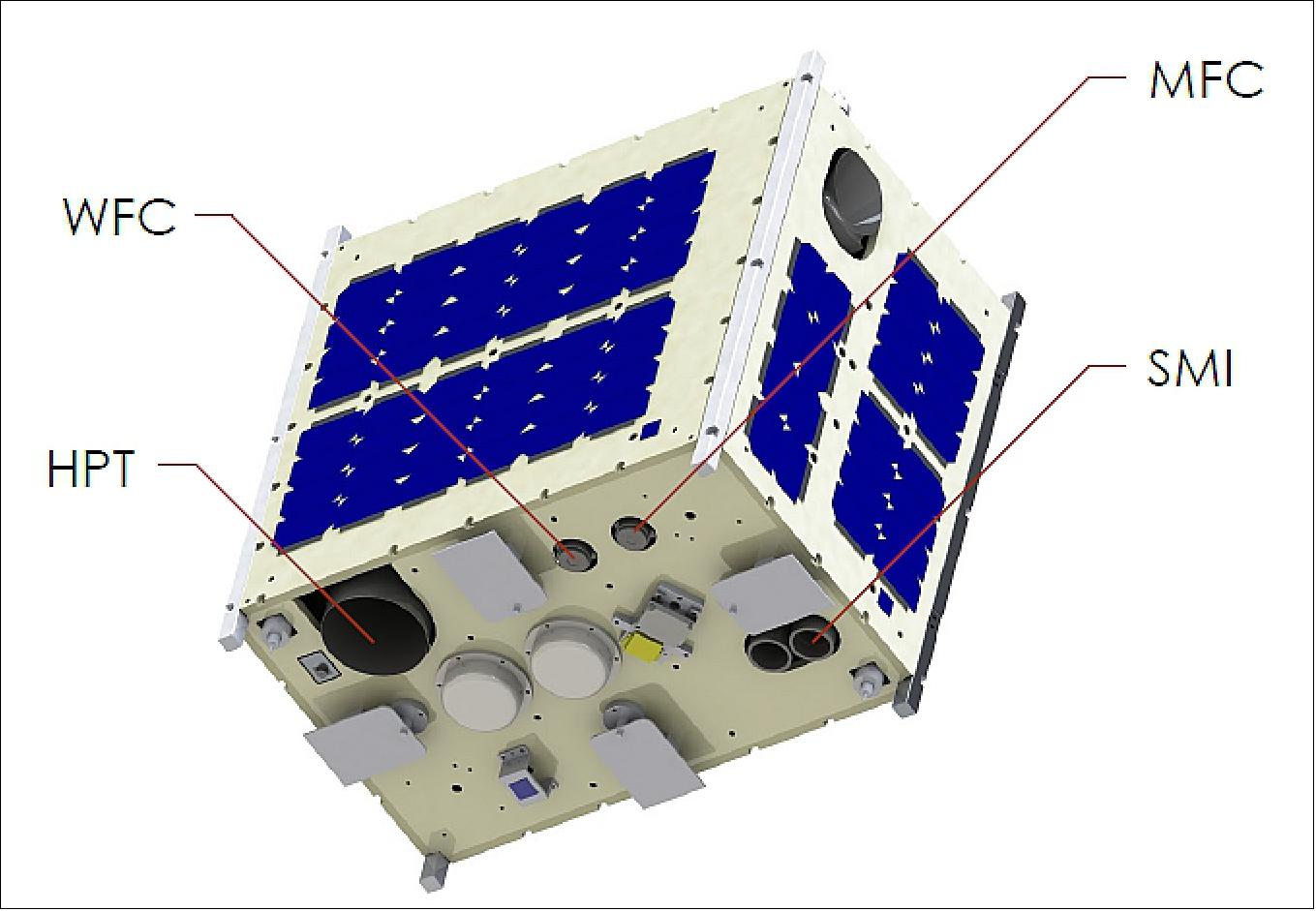
Ground Segment
A GRS (Ground Receiving Station) has been established at UP (University of the Philippines) Diliman, Quezon City, Philippines, for the reception of the imagery from the Diwata-1 microsatellite. The station can also be used to control and transmit commands from the ground to the microsatellite to carry out its mission effectively. The GRS is named the PEDRO (Philippine Earth Data Resources and Observation) facility.
The Philippine Council for Industry, Energy and Emerging Technology Research and Development of the DOST/ASTI (Department of Science and Technology)/Advanced Science and Technology Institute) is the monitoring agency of the PHL-Microsat Program.
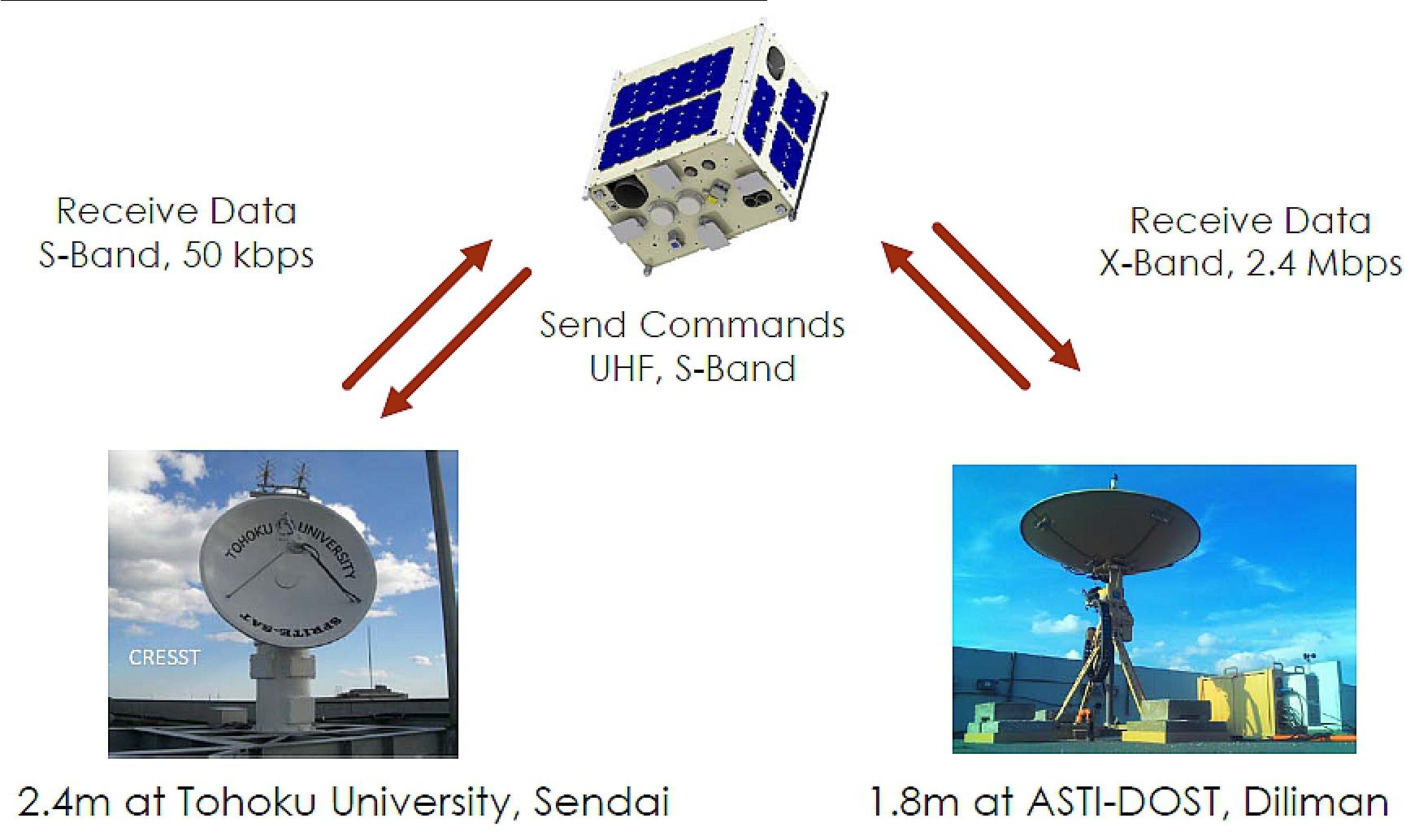
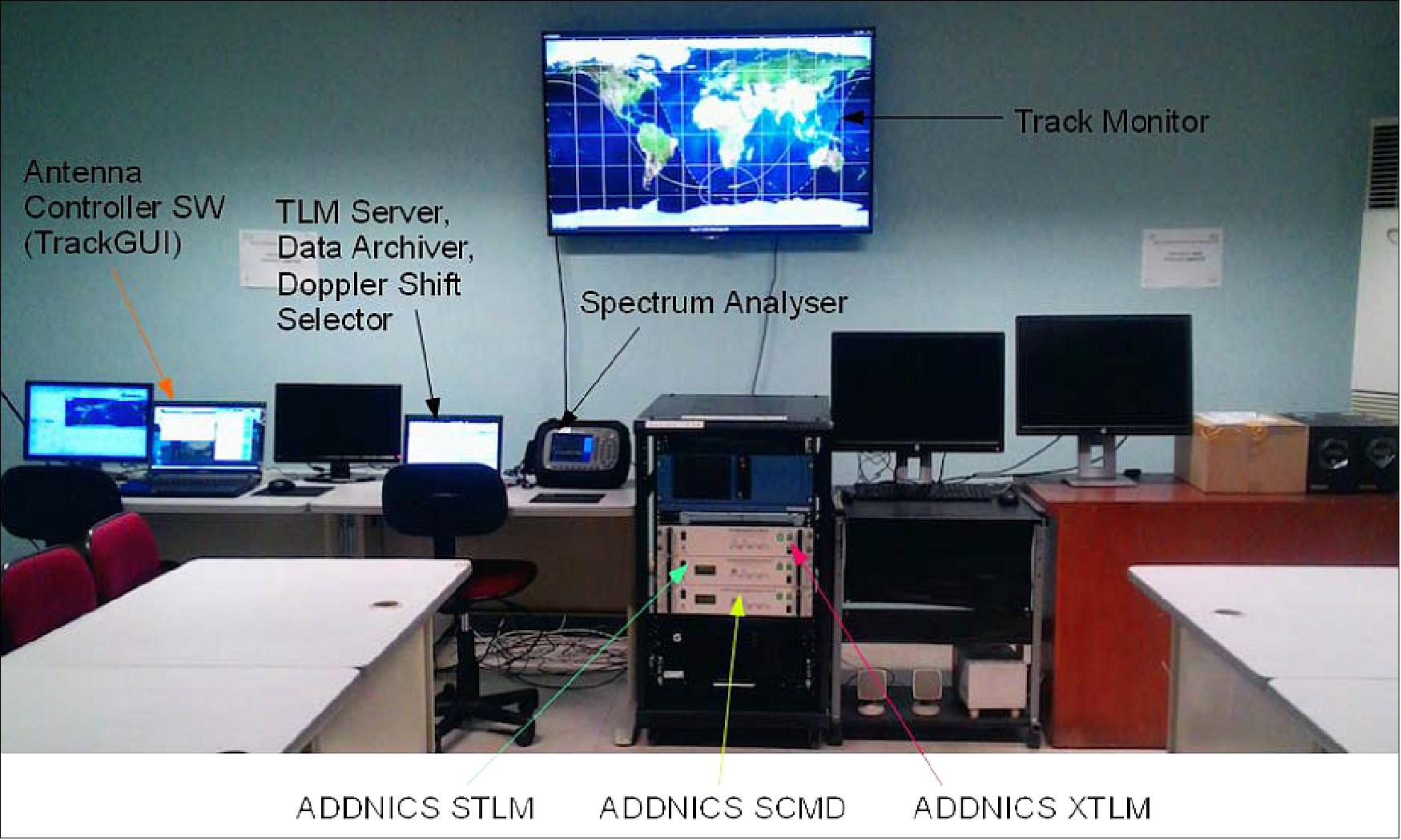
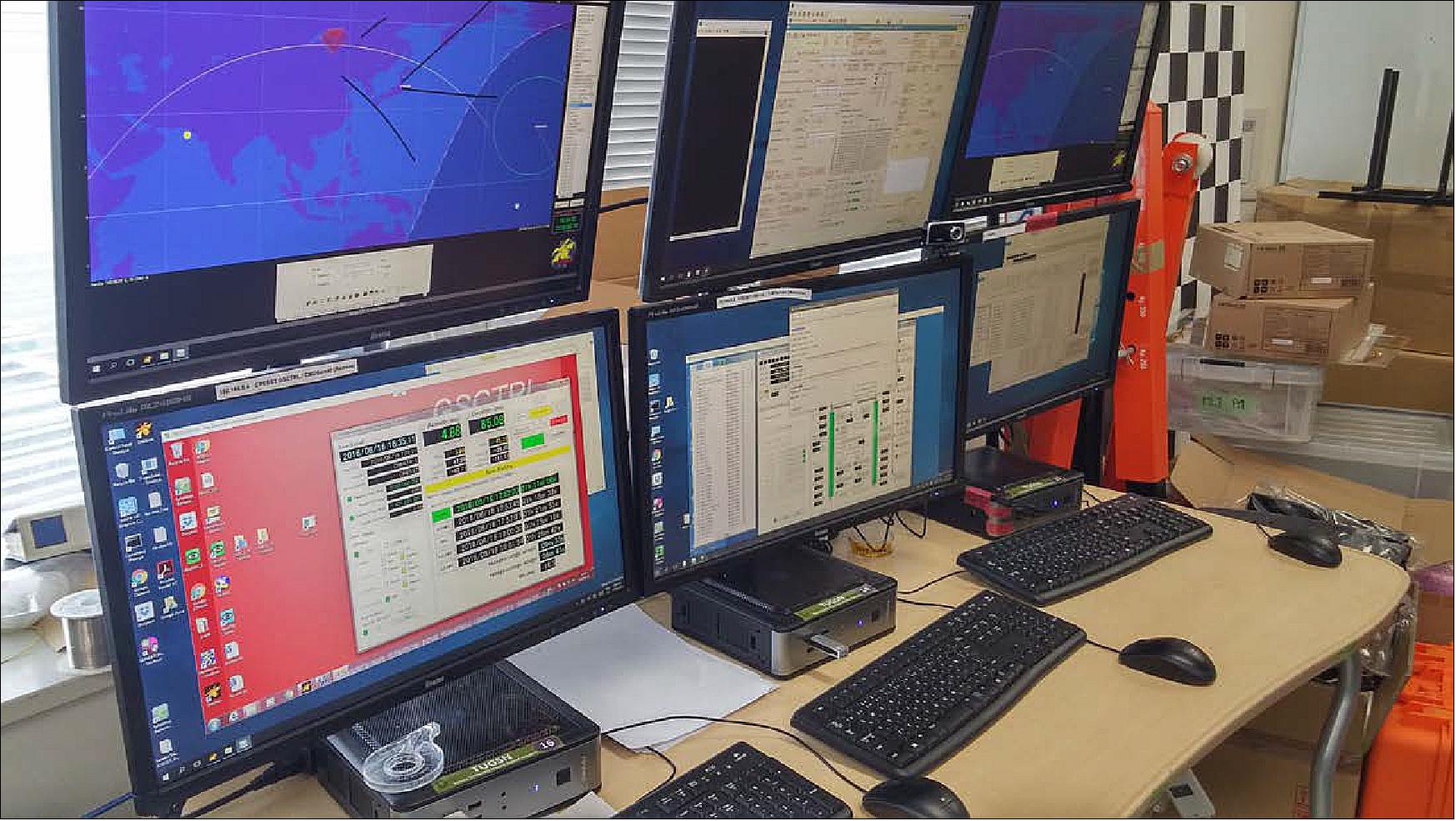
1) "Diwata-1," Wikipedia, URL: https://en.wikipedia.org/wiki/Diwata-1
2) "Filipino scientists complete 50kg microsat with help from Japan," Space Daily, Feb. 24, 2016, URL: http://www.spacedaily.com/reports/
Filipino_scientists_complete_50kg_microsatellite_with_help_from_researchers_in_Japan_999.html
3) Harold Bryan S. Paler, Kaye Kristine Vergel, "Development and Operation of DIWATA-1 Microsatellite," The 23rd Session of the Asia-Pacific Regional Space Agency Forum (APRSAF-23), Manila, the Philippines, November 15-18, 2016, URL: http://www.aprsaf.org/annual_meetings/aprsaf23/pdf/working_groups/sawg/AP23_SA_Day1_1300.pdf
4) "The Philippine's 50-kg-class microsatellite "DIWATA-1" has been received. Diwata-1 will be released from Kibo this spring," JAXA, Feb. 3, 2016, URL: http://iss.jaxa.jp/en/kiboexp/news/160203_diwata1_sat.html
5) "Philippines' DIWATA microsatellite Rising," DOST, URL: http://pcieerd.dost.gov.ph/images/callforproposal/diwata/PCIEERDPRforMicrosat-1152016.pdf
6) "Philippines' DIWATA microsatellite Rising," GOVPH (Government of the Philippines), Jan. 22, 2016, URL: https://web.archive.org/web/20160325054626/http://pcieerd.dost.gov.ph/news/187-philippines-diwata-microsatellite-rising
7) Cheryl Warner, Dan Huot, "NASA Sends Fire, Meteor Experiments to International Space Station on Commercial Cargo Spacecraft," NASA, Release 16-036, March 23, 2016, URL: http://www.nasa.gov/
press-release/nasa-sends-fire-meteor-experiments-to-international-space-station-on-commercial-cargo
8) Steven Siceloff, "Cygnus Cargo Ship, Atlas V Blaze Path to Station," NASA, March 23, 2016, URL: http://www.nasa.gov/feature/cygnus-cargo-ship-atlas-v-blaze-path-to-station
9) Kathryn Hambleton, Tracy Young, "NASA TV Coverage Set for Fifth Orbital ATK Resupply Mission to Space Station," NASA, March 17, 2016, URL: http://www.nasa.gov/press-release/
nasa-tv-coverage-set-for-fifth-orbital-atk-resupply-mission-to-space-station-0
10) Steven Siceloff, "Cygnus Set to Deliver Its Largest Load of Station Science, Cargo," NASA, March 18, 2016, URL: http://www.nasa.gov/feature/cygnus-set-to-deliver-its-largest-load-of-station-science-cargo
11) "Sticky, stony and sizzling science launching to space station," Science Daily, Source NASA/JSC, March 9, 2016, URL: https://www.sciencedaily.com/releases/2016/03/160309140040.htm
12) "Strata-1," NASA News, Nov. 22, 2016, URL: https://www.nasa.gov/mission_pages/station/research/experiments/2146.html
13) Rosa Mina, "Philippines bids farewell to satellite that launched enviro policy into the space age," Mongaby News, 12 May 2020, URL: https://news.mongabay.com/2020/05/
philippines-bids-farewell-to-satellite-that-launched-enviro-policy-into-the-space-age/
14) "2017: Diwata-1's Year in Review," 31 Dec. 2017, URL: https://blog.phl-microsat.upd.edu.ph
/2017-diwata-1s-year-in-review-6e194c64468d
15) "After success of Diwata-1 microsatellite, DOST now planning Diwata-3," Newsbytes, May 9, 2017, URL: http://newsbytes.ph/2017/05/09/
after-success-of-diwata-1-micro-satellite-dost-now-planning-diwata-3/
16) "Diwata launch: 1 year later," UP Diliman, 5 May, 2017, URL: https://upd.edu.ph
/diwata-launch-1-year-later/
17) "Tracking a Diwata , Part 1: Introduction," PHL microsat, Jan. 13, 2017, URL: https://blog.phl-microsat.upd.edu.ph/tracking-a-diwata-introduction-39da0f9a0ea3#.rjui2p8bc
18) "Successful Deployment of DIWATA-1, First Microsatellite developed by the Republic of the Philippines, from ISS Kibo (JAXA's first success of 50 kg-class microsatellite deployment)," JAXA Press Release, April 27, 2016, URL: http://global.jaxa.jp/press/2016/04/20160427_diwata1.html#pict
19) "Successful Deployment of the Philippine‘s First Microsatellite "DIWATA-1" from the Kibo/ISS," JAXA, April 27, 2016, URL: http://iss.jaxa.jp/en/kuoa/news/160427_diwata1_deployed.html
20) Kaye Kristine Vergel, Benjamin Jonah Magallon, Yukihiro Takahashi, Tetsuro Ishida, Gay Jane Perez, Mark Edwin Tupas, Joel Marciano, "Science Missions and Payloads Specifications of Philippines' First Earth-Observation Microsatellite: Diwata," November 2, 2015, Poster, URL: https://secure.jproduce.co.jp/sgepss/sessionFinal/html/program/pdf/S001/S001-P01.pdf
The information compiled and edited in this article was provided by Herbert J. Kramer from his documentation of: "Observation of the Earth and Its Environment: Survey of Missions and Sensors" (Springer Verlag) as well as many other sources after the publication of the 4th edition in 2002. - Comments and corrections to this article are always welcome for further updates (eoportal@symbios.space).
Spacecraft Launch Mission Status Sensor Complement Ground Segment References Back to top